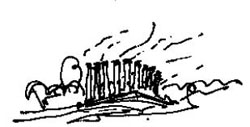Some Like It Hot, But It's Not a Good Idea
Time to shine a “bright” light upon one of the dark sides of construction… FIRE!

On our recent tour of Louisiana plantations we were fortunate to stay at Madewood near Lafayette in a 14 ft high ceilinged room. However, I was appalled that the only things standing between the owners of this 30-year restoration project and a pile of ashes were battery powered smoke detectors, an alert resident, a working phone and the local volunteer fire department. This revelation foreshadowed the sobering part of our tour: the recent loss of Tezcuco to fire, and the recent total reconstruction of Greenwood near St. Francisville which had been totally destroyed by a fire that left only its massive brick columns and chimneys standing. Gone were the patina of age, charming sags, hand cut moldings and the feeling that generations of residents had left, however subtle, and layers of fashion and contradictory decorating ideas.

Construction is a dangerous time, especially for dry, old historic structures. Recently, I was dismayed to hear from a hard working couple who had labored for several years on a modest federal house that a worker trying to remove difficult paint chose heat and ignited a major blaze. Imagine the after effects of these other common practices: cutting or grinding through metal creating an array of inadvertent sparks; bad wiring undergoing repair or, worse yet, a wall containing undetected bad wiring being taken down; roofers using torches and hot air guns to seal certain roofing materials. Unfortunately, workers often put bags over smoke detectors to keep dust out and to prevent false alarms, yet rarely remove them when they leave the job each day.
Although fire will always be a statistical probability, every measure within a worst-case, maximum budget should be taken to reduce the odds. Hire an architect to visit during the construction phase. Engage a careful contractor who takes fire-safety concerns seriously. Carefully drawn project specifications or the preconstruction meeting can require fire extinguishers be within reach, any heat work should stop two hours before quitting time, plus a fire watch and walk thru and log to make record of safety observations before the job is shut down each night.

Of course, the owner and contractor must have proper insurance with sufficient coverage to pay for historic replication, not just utility grade repairs and paid-up premiums. While some may argue against sprinkler systems for aesthetic reasons or because of real damage that occurs during installation, I have come to see them as the lesser of two evils when an irreplaceable historic asset such as a National Historic Landmark is involved. Sprinklers are not simple piping problems, because they can include storage tanks, emergency generators, compressors and regular maintenance to minimize accidental leaks. Some argue that sprinklers come too late, after the fire has started. . .that early detection with electronics is superior. Yet, these systems too, can be unreliable because they depend on flukey electronics, working phone lines, batteries and a skilled fire department, not swamped with other calls. Ideally, the most important buildings would have both systems. At the other end of the spectrum are private homes whose owners should follow the local codes that require some sprinklers and electronic detection for smoke & carbon monoxide as a minimum and invite the fire marshal to inspect before and during the work.
The Association of Preservation Technology Bulletin XXXIV No.4 published last winter includes a thoughtful article on this troublesome topic. Available on their website, research libraries or at my new office.
Tezcuco is (was) distinguished for the meticulous execution of its interior detail. Referred to as a “raised cottage” its front corner rooms are 25 feet square, with 15 foot ceilings.
— Plantations of Louisiana and The Natchez Area David King Gleason
BRIGHT NEWS & VIEWS
+ Moved to New Office in interesting downtown New Haven!!! As they say in Alabama “Y’all come and see us!”.
+ Architectural Alliance will sponsor my reflections “Restoring an 1763 Cape vs. HGTV Fairy Tale” Two years of my detection work, careful drawings & specs, construction and challenging closeout vs. the 9 minute summary created for national TV. Wednesday, September 22nd at 7:30 pm at the Neighborhood Music School, 100 Audubon Street, New Haven. $5 admission goes to a good cause.
+ Masonry Restoration at Center Church on Green New Haven: Interesting chimney investigations going on.
+ Church of God and Saints of Christ: Challenges embedded in their picturesque Queen Anne “country” church.
+ Pleased to be asked to plan the restoration the Madison Historical Society’s Allis/Bushnell House: True Colonial “reverse saltbox”with an array of puzzles to be solved sensibly.
+ Manchester Historical Society asked for my proposal to advise them on their 20,000 sf brick mill.
BRIGHT SPOTS

We just got back from Sweden, Maine where my wife and I headed the arts and crafts program for fiftyone girls ages 8-12 who had lost a parent. For the third year Circle of Tapawingo provided a free week of fun — thanks to a grant, great organizers, volunteers and a generous camp owner. This year’s projects included sun prints, brilliant water color magic, decorative polymer pens and GLITTER! More info and a handsome picture of our dog on the web at circleoftapawingo.org.
